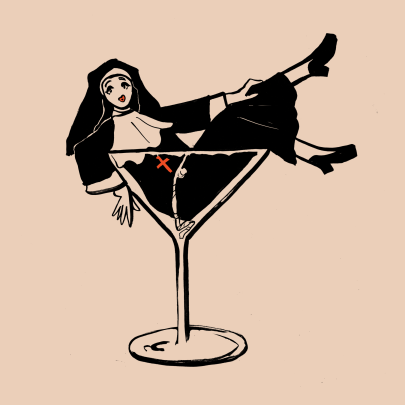May 5, 2015 Theatre
Auckland Theatre Company
Maidment Theatre
If we lived 100 years ago, what would you miss most: the vote, the pill or the washing machine? It’s a question Emily Perkin’s Nora (Laurel Devenie) has picked up in a woman’s magazine and poses to her dismissive friend Christine (Nicola Kawana). If the action of Henrik Ibsen’s Nora slamming the door on her family heralded the coming of modern feminism, the question is an obvious nod to the progress that separates the 1879 Norwegian Nora, and the 2015 New Zealand Nora. And yet…
Auckland Theatre Company’s artistic director Colin McColl has form for localising Ibsen. His international reputation was built on the 1990 Downstage production of Hedda Gabbler, which retooled the setting to the small-town mentality of 1950s New Zealand and toured to Edinburgh, Oslo, London and Sydney.
This fact has appeared in all of his bios in the ATC programmes over the years, but despite his status as an Ibsen expert, he hasn’t attempted any of Ibsen’s works with this company until now. Perkins was approached by ATC to adapt the play, a commission she says she accepted with glee, then terror.
It’s been rather fashionable in Australia in recent years to present Classics From The Western Canon in updated and localised adaptations, spearheaded by the controversial director Simon Stone (you might remember Silo’s 2011 production of The Only Child). Yet while his detractors sometimes aim the style-over-substance criticism his way, Perkins’ adaptation is substantial and purposeful.
Ibsen’s Nora is ahead of her time, but she is, nevertheless, so captured by her society that any attempt to enfranchise her and re-set the action needs some fundamental rewriting. For example, one of the major plot points in the original is predicated on her inability, as a woman, to gain a legitimate loan from the bank. So she borrows money from the toady Nils Krogstad and tells her husband she received it as inheritance.
In this production, Nora’s decision to accept a loan from her husband’s building colleague Aidan seems more like a poor character judgment.
In the Ibsen, she is adamant the money was to save her husband, who was blighted by depression: they used it to fund a trip to Italy. In the Perkins, Nora also says her husband’s mental health prompted her to seek the loan, but you can’t escape the notion she wanted the house that money would help provide just as much.
In its day, Ibsen’s play was attacked as perverse and indecent, and Nora as unwomanly. You read the play now, and you think, of course she would do what she did. From the first scene, where husband Torvald is the clear master to her subservient “squirrel”, it is obvious that Nora is suffocated by the patriarchal society of the period. Put this Ibsen on now and we’d have the comfort that distance brings: we might still have gender inequalities, but not as bad as they had it.
The brilliance of Emily Perkins’ play is she sets up a social world within the family unit that at first looks normative and uncontroversial. Husband Theo (Damien Avery) is a top bloke, a building contractor and practical man who shares the parenting – he first enters holding the kids and places them into bed. Theo and Nora have a fire for each other: “Tell me about steel reinforcing,” she mews, as she tries to undo his pants.
Perkins also brings to her debut stage-play her novelist’s skill at rich character detailing. Where Ibsen’s Krogstad can be cartoonish, Paul Glover’s Aidan is more opportunist than malicious. It is Nora who treats Aidan like dirt, and this non-empathetic people management is a decisive factor in his later blackmail.
Nora receives unwanted male attention from ill family friend Gerry (Peter Elliott), which as our prime minister has learnt is never okay, but Perkins is also interested in questioning how far Nora pushes it. With these characters, it is difficult to sit there and lay fault. It’s easy to claim Ibsen’s Nora as a feminist icon, but the complexity of Perkin’s Nora resists such labelling.
But enough gendered discourse, let’s talk about the pandas. You’ll certainly be talking about Nora’s decisions in the foyer post-show, but you’ll likely spend just as much time talking about these polarising little animals. In a massive design decision from Tony Rabbit and McColl, most of the action takes place downstage in a pit filled with panda soft toys. Row after row of them, a thousand in all.
It’s a bold expressionist move and anti-Ibsen-realism. There’s so much for the actors to play with – they dive into them, throw them around, and Nora’s ever-present young children have a great hide-and-seek game with them. With those panda faces peeking out at us it all looks quite dissociatively creepy, a panda-gremlin menace that could animate at any time and take over the social order.
We can read the pandas easily enough as a reflection of Nora’s psychological state: with a perfectionist streak she is desperate to keep her world ordered – soft and squishy – but she also buries chocolate bars beneath them, banned by sugar-free Theo, scooping them out when no one else is watching.
The pandas’ exterior might point towards the desire for a black-and-white world, but Nic Smillie’s costumes and the set’s walls are, significantly, in greyscale. There’s something about these pandas that is troubling for Western society too, because the props are literally made in China. Nora and Theo are living a Kiwi dream: Theo is constructing their trendy eco-house off the grid.
They’ve put everything into it, and legislated a policy of austerity to help with the mortgage. No television for them, and their water source often dries up. And yet, Nora and Theo are just as blinkered by consumer culture, allowing mass-produced, ethically questionable goods into their sanctuary-prison. Commercial exploitation is the unacknowledged floor that Western society is built on – how’s that for a statement?
Rabbit has gone for his own austerity in his lighting design, using just three lights, which adds to the sense that the home is not yet complete and perhaps never will be. These three lights have quite a few tricks in them, though, and are put through their paces in psychologically disturbing transitions where John Gibson’s compositions lend a tone of impending disintegration.
I’m not convinced all the exterior shows at representing Nora’s troubled interior are necessary – the brief appearance of a monster-troll seems to play the production’s cards too openly – but it certainly adds to our anticipation of the moment where this doll’s house is going to smash right open. Colin McColl’s direction hasn’t been this energised in a long time.
Now back to that discourse. Actually I never did leave that discourse, did I? The position of 21st-century gender roles is fascinating in this play. I’m looking throughout for what contemporary statements it is making, and there’s a lot to uncover.
Is Nora a victim, or has she made a series of bad choices? Nora and Theo are trying to make their way, raise their family, and these are good values, aren’t they? Divorcee Christine reminds Nora that Nora’s schoolyard nickname was “Princess”; she in turns reminds Christine that hers was “Town Bike”.
Masculinity and femininity are troubled: there are no good models, and no certainty about what is permissible, what is patriarchal, what is empowering. Should we celebrate Nora’s opportunity to be a full-time mother, or should she have returned to the workforce rather than taking that dubious loan? What is best for the kids? Would Theo have allowed it even if she wanted to?
Theo is not Torvald, but while he projects an image of the enlightened modern man (in contrast to beer-sculling Aidan), he’s still stuck in his duty as provider, a world view where dependence on others emasculates him. And he can be every bit as patronising of Nora, in a modern way, as Torvald was in his upstanding 19th Century habits. The knot of gender, social, economic and ethical crises in this work is next to impossible to untangle.
The drama is thick, and tense. Perkins has lobbed a grenade onto the stage and we wait anxiously for it to explode. The means of getting there is Perkins, but the end-game is Ibsen’s. Devenie, who has been so utterly compelling as Nora throughout, amps her performance in the final scene to a level of breath-taking intensity. Her decision to act is sudden and provocative.
This drama challenges our social complacency and certainty. Emily Perkins’ theatrical debut is just what this country needs right now.
A Doll’s House: Maidment Theatre, to May 23. atc.co.nz





